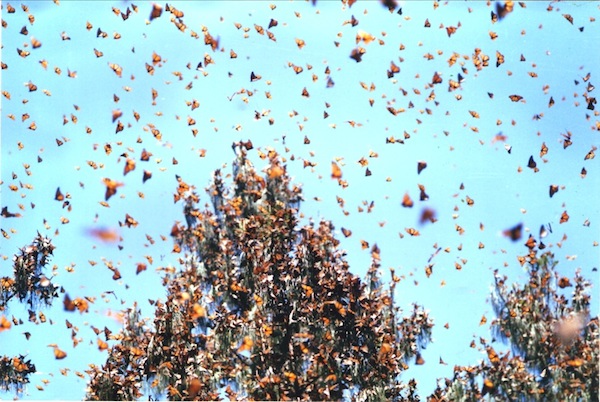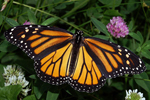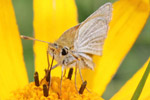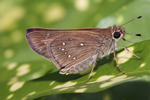New research shows most Americans place importance on the protection of the ailing monarch butterfly, which is experiencing a steep decline in numbers. The study, published in Conservation Letters, found nearly three-quarters of those surveyed support conservation efforts for the iconic species, and are willing to spend several billion dollars to help.
The monarch is the official insect or butterfly of seven U.S. states, and is celebrated in a number of festivals held across North America. The annual migration of monarch butterflies (Danaus plexippus) is one of nature’s most beautiful sights. Millions of the insects migrate annually from the as far north as Nova Scotia all the way down to wintering grounds in the forests of Mexico, a journey of up to 3,000 miles (4,800 kilometers) that takes four generations.
However, each year fewer and fewer monarch butterflies make the trip, as populations have been declining across North America for about 15 years. Recent surveys at the wintering grounds of monarchs in Mexico showed the lowest colony size ever recorded.

A wintering mass of monarchs. Photo by: Raina Kumra.
To estimate population size, researchers measured monarch numbers while they were assembled en mass at their wintering grounds. During the 2013-2014 winter season, the butterflies covered 0.67 hectares in Mexico’s forests, a drop of 44 percent from 2012. Overall, the average monarch coverage from 1994-2014 was 6.39 hectares – nearly ten times higher than the 2013 estimation.
Much of the decline in monarch numbers has been blamed on the loss of milkweed, the native plants on which monarch caterpillars feed. Karen Oberhauser, a monarch biologist from the University of Minnesota and co-author of the study, said breeding, migrating and overwintering habitat loss are the main factors affecting monarch populations.
“In the U.S., the growing use of genetically-modified, herbicide-tolerant crops, such as corn and soybeans, has resulted in a severe decline in milkweed, and thus a loss of breeding habitat,” Oberhauser said.
The findings of the study showed more than half of the American respondents were “not aware” of the declines in monarch populations, while 39 percent were familiar with the issue. Seventy percent of those questioned believed conserving monarchs was important, while three percent said it was not important.
According to Jay Diffendorfer, a USGS scientist and the study’s lead author, while the multigenerational migration of the monarch butterfly is considered one of the world’s most spectacular events, protection of the species is challenging.

Monarch butterflies produce four generations every year. Most live only a few weeks, but the fourth generation lives several months in order to complete their journey. Photo by: Kenneth Dwain Harrelson.
“Managing migratory species is difficult because they can cross international borders and depend on many geographic areas for survival,” he said. “However, the life cycle of monarchs creates opportunities for untapped market-based conservation approaches.
The survey asked respondents across the U.S. whether they would be happy to donate money for the conservation of monarchs, and whether they would pay to plant monarch-friendly nectar or milkweed plants.
The researchers received heartening responses to the survey. In total, their study indicates that the U.S. public is willing to spend between $4.78 billion and $6.64 billion to help protect the monarch butterfly.
“The study shows that not only might consumers pay more for monarch-friendly milkweeds grown without systemic insecticides in the potting soil, but also that consumers might be more interested overall in buying nectar-producing plants or milkweeds if they knew a small percentage of sales will be donated to habitat conservation,” Diffendorfer said.
“Ordinary households, conservation organizations, and natural resource agencies can all plant milkweed and flowering plants to offset ongoing losses in the species’ breeding habitat.”

Monarchs have declined precipitously over the past 20 years. Photo courtesy of Monarch Watch.
Citations:
- Diffendorfer J et al. (2013) Natural valuation of monarch butterflies indicates an untapped potential for incentive-based conservation. Conservation Letters 00 (2013) 1-10.
Related articles
Losing our monarchs: iconic monarch butterfly down to lowest numbers in 20 years

(07/15/2013) In the next few months, the beating of fragile fiery orange and black wings will transport the monarch butterfly south. But the number of monarch butterflies (Danaus plexippus) reaching their final destination has steadily declined, dropping to its lowest level in two decades last winter, according to a recent survey.
Zoo races to save extreme butterfly from extinction

(08/15/2013) In a large room that used to house aquatic mammals at the Minnesota Zoo, Erik Runquist holds up a vial and says, ‘Here are its eggs.’ I peer inside and see small specks, pale with a dot of brown at the top; they look like a single grain of cous cous or quinoa. Runquist explains that the brown on the top is the head cap of the larva, a fact that becomes more clear under a microscope when you can see the encased larva squirm. I’m looking at the eggs of a Poweshiek skipperling, a species that is more imperiled than pandas, tigers, or bluewhales. Once superabundant, only several hundred Poweshiek skipperlings may survive on Earth today and the eggs I’m looking at are the only ones in captivity.
Florida declares two butterfly species extinct as pollinator crisis worsens

(08/01/2013) Conservationist’s faced a crushing blow last month as two butterfly species native to Florida were declared extinct.
‘Occasionally, these types of butterflies disappear for long periods of time but are rediscovered in another location,’ said Larry Williams, U.S. Fish and Wildlife state supervisor for ecological services. We think it’s apparent now these two species are extinct.’
Habitat loss and pesticides causing decline in Europe’s butterflies
(07/31/2013) Europe’s grassland butterfly population has plummeted in the past two decades, new research published on Tuesday shows, with a near halving in the numbers of key species since 1990.













